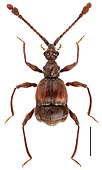Rove beetle
| Rove beetles Temporal range:
| |
|---|---|

| |
| Rove beetles of western Eurasia | |
| Scientific classification | |
| Domain: | Eukaryota |
| Kingdom: | Animalia |
| Phylum: | Arthropoda |
| Class: | Insecta |
| Order: | Coleoptera |
| Suborder: | Polyphaga |
| Infraorder: | Staphyliniformia |
| Superfamily: | Staphylinoidea |
| Family: | Staphylinidae Latreille, 1802 |
| Subfamilies | |
| |
The rove beetles are a
One well-known species is the
Anatomy
As might be expected for such a large family, considerable variation exists among the species. Sizes range from <1 to 35 mm (1.4 in), with most in the 2–8 mm range, and the form is generally elongated, with some rove beetles being ovoid in shape. Colors range from yellow and red to reddish-brown to brown to black to iridescent blue and green. The antennae usually have 11 segments and are filiform, with moderate clubbing in some genera. The abdomen may be very long and flexible, and some rove beetles superficially resemble earwigs.These beetles are able to fold themselves into a sort of origami shape. In the genera Paederinae, Euaesthetinae, and Osoriinae, and partially in Steninae, the tergum and sternum on the visible abdominal segments have fused, making each segment ring-shaped.[3]
Some rove beetles, including members of Antimerus[4] and Phanolinus,[5] are metallic in appearance.
Some members of
Ecology
Rove beetles are known from every type of
Although rove beetles' appetites for other insects would seem to make them obvious candidates for
Rove beetles of the genus
Systematics
Classification of the 63,650 (as of 2018) staphylinid species is ongoing and controversial, with some workers proposing an organization of as many as 10 separate families, but the current favored system is one of 32 subfamilies, about 167 tribes (some grouped into supertribes), and about 3,200 genera. About 400 new species are being described each year, and some estimates suggest three-quarters of tropical species are as yet undescribed.[citation needed]
Gallery
References
- ISSN 0102-7786.
- S2CID 86429652.
- ^ rove beetles - Staphylinidae
- PMID 21594033.
- PMID 34887695.
- ISBN 978-1-4020-6242-1.
The 28 species thus far shown to produce such a toxin belong to three of the 14 genera of Paederina, namely Paederus, Paederidus, and Megalopaederus
- ^ "Ectoparasites". Institute of Tropical Medicine, Antwerp. Archived from the original on 2007-03-05. Retrieved 2007-06-04.
- PMID 22792029.
- JSTOR 1933627.
- Greenwood Press.
- Ross H. Arnett, Jr. and Michael C. Thomas, American Beetles(CRC Press, 2001), vol. 1
- Betz O., Irmler, U. and Klimaszewski, J. (eds.) Biology of rove beetles (Staphylinidae) - Life history, evolution, ecology and distribution (Springer, 2018)
(Méndez-Rojas, Cultid-Medina and Escobar, 2022)
Important works
For the
- Lohse, G.A. (1964) Familie: Staphylinidae. In: Freude, H., Harde, K.W. & Lohse, G.A. (Eds.), Die Käfer Mitteleuropas. Band 4, Staphylinidae I (Micropeplinae bis Tachyporinae). Krefeld: Goecke & Evers Verlag, 264 pp.
- Lohse, G.A. (1974) Familie: Staphylinidae. In: Freude, H., Harde, K.W. & Lohse, G.A. (Eds.), Die Käfer Mitteleuropas. Band 5, Staphylinidae II (Hypocyphtinae und Aleocharinae). Pselaphidae. Krefeld: Goecke & Evers Verlag, 381 pp.
- Lohse, G.A. (1989) Ergänzungen und Berichtigungen zu Freude-Harde-Lohse "Die Käfer Mitteleuropas" Band 5 (1974), pp. 185–243 In: Lohse, G.A. & Lucht, W.H. (Eds.), Die Käfer Mitteleuropas. 1. Supplementband mit Katalogteil. Krefeld: Goecke & Evers Verlag, pp. 185–243.
Regional works
Europe
- Lott, D.A. (2009). The Staphylinidae (rove beetles) of Britain and Ireland. Part 5: Scaphidiinae, Piestinae, Oxytelinae. Handbooks for the identification of British insects, vol. 12, part 5. St Albans: Royal Entomological Society. British and Irish fauna only
- Tronquet, M. (2006). Catalogue iconographique des Coléoptères des Pyrénées-Orientales. Vol. 1: Staphylinidae. Supplément au Tome XV de la Revue de l’Association Roussillonnaise d’Entomologie. Perpignan: Association Roussillonnaise d’Entomologie.Extensively illustrated
External links
- Digital Library of Early Works on Staphylinidae
- Catalog of the Staphylinidae1758 to the end of the second millennium.[1]
- rove beetles of the world on the UF / IFAS Featured Creatures Web site
- rove beetles of Florida on the UF / IFAS Featured Creatures Web site






